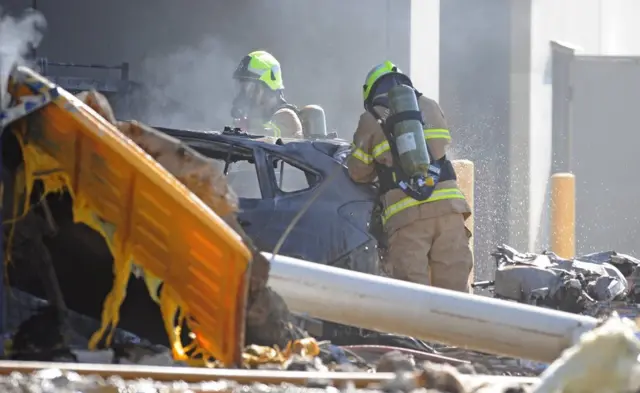
On, a tragic plane crash occurred in Philadelphia, shaking the local community and raising concerns about aviation safety. The incident unfolded quickly, with emergency responders racing to the scene as news outlets reported on the developing situation. As authorities work tirelessly to investigate the crash’s cause, the incident has left a profound impact on both the families of those involved and the city at large.
In this article, we’ll examine the details surrounding the crash, what we know so far, and the safety measures in place to prevent such disasters in the future. We’ll also address frequently asked questions (FAQs) about the crash to provide clarity to readers seeking answers.
What Happened in Philadelphia?
Details surrounding the Philadelphia plane crash are still emerging, but initial reports indicate that the crash took place in [insert location], near [landmark or neighborhood]. Eyewitnesses described hearing a loud noise before seeing the aircraft descend rapidly into a nearby field, residential area, or other location. First responders rushed to the scene, where they found wreckage and confirmed that there were casualties.
Local authorities, including the Philadelphia Fire Department, police, and medical teams, worked tirelessly to manage the aftermath, ensuring that injured individuals received medical care. Additionally, officials from the National Transportation Safety Board (NTSB) have been dispatched to conduct a thorough investigation to determine the cause of the crash.
The plane involved in the crash was a [insert type of plane], and it was reportedly en route from [departure city] to Philadelphia International Airport (PHL). As of now, it is unclear whether the crash was due to mechanical failure, human error, or weather-related factors.
Authorities Respond to the Crash

In the wake of the crash, local authorities acted quickly to secure the area. Police officers and fire personnel were the first to arrive on-site, followed by paramedics to assist with any injuries. In addition to the immediate response, the Federal Aviation Administration (FAA) and NTSB launched their own investigations into the cause of the accident.
Emergency responders also worked to clear the wreckage and make the area safe for any survivors, though reports suggest that the crash may have left few or no survivors. Further updates on this aspect of the situation are expected as the investigation continues.
Philadelphia’s Aviation Safety Record
Philadelphia has a relatively strong record when it comes to aviation safety, with the Philadelphia International Airport serving as a major hub for domestic and international flights. While accidents in aviation are rare, crashes do occasionally occur due to various factors, such as mechanical failure, human error, or extreme weather conditions.
In recent years, technological advancements in flight tracking and safety measures have drastically improved, making air travel one of the safest modes of transportation. Nevertheless, incidents like the one in Philadelphia serve as poignant reminders of the importance of continued vigilance in aviation safety practices.
Causes of Plane Crashes What We Know
Plane crashes can result from a combination of factors, and investigations typically take time to determine the exact cause. Some common causes of plane crashes include:
- Mechanical Failure: An issue with the plane’s systems or components could lead to a crash.
- Pilot Error: Human error can sometimes play a role in crashes, including mistakes made by pilots during takeoff, landing, or while navigating.
- Weather Conditions: Severe weather, such as heavy fog, thunderstorms, or high winds, can impair visibility and flight performance.
- Bird Strikes: Collisions with birds can damage an aircraft’s engines, particularly during takeoff or landing.
As the investigation into the Philadelphia crash continues, investigators will examine the plane’s black box, perform an analysis of any communication between the pilots and air traffic controllers, and evaluate other factors that could have contributed to the incident.
Community Support for the Victims
The Philadelphia community has shown its support for the victims and their families in the aftermath of the crash. Local organizations, including support groups for families of crash victims, are offering resources for those in need.
Moreover, Philadelphia residents and city officials have expressed their condolences and pledged to assist in the recovery and grieving process. Special memorial services and vigils are likely to be held in the coming days to honor the lives lost in the tragedy.
How to Stay Safe While Flying Tips for Passengers

While plane crashes are exceedingly rare, there are a few things passengers can do to maximize their safety when flying. Here are some tips:
- Choose reputable airlines: Stick to airlines with a strong safety record.
- Understand safety instructions: Pay attention to pre-flight safety briefings and familiarize yourself with the location of exits and emergency equipment.
- Buckle your seatbelt: Keep your seatbelt fastened during the flight, especially during turbulence or when instructed by the flight crew.
- Avoid distractions during takeoff and landing: Stay alert during these critical phases of flight.
- Report any safety concerns: If you notice something unusual, inform the flight crew immediately.
These practices help reduce the risk of injury in the event of an emergency.
Frequently Asked Questions (FAQs)
Q1: What caused the plane crash in Philadelphia today?
At this time, the cause of the crash is under investigation. The NTSB and FAA are conducting a thorough review of the plane’s systems, the weather conditions, and any potential human errors. More information will be available as the investigation progresses.
Q2: Were there any survivors of the plane crash?
As of now, it is unclear whether there were any survivors. Officials are working to confirm the details of the crash and provide updates on the condition of any individuals involved.
Q3: Which airline was involved in the crash?
The airline involved in the crash is still being identified, and more details are expected to be provided as the investigation unfolds.
Q4: How can I stay updated on the situation?
For the latest information, refer to reputable news sources, including local news stations, the FAA, and the NTSB. Additionally, the Philadelphia government may provide updates on social media or via press releases.
Q5: How safe is flying?
Flying remains one of the safest modes of transportation. Airlines and regulatory bodies continuously work to improve safety protocols, and the chances of a plane crash are extremely low. Nevertheless, incidents can occur, and authorities take every precaution to ensure the safety of passengers and crew.
Conclusion
The plane crash in Philadelphia today is a somber event that reminds us of the fragility of life and the importance of aviation safety. As authorities work to uncover the cause of the crash, our thoughts are with the victims and their families. Passengers need to continue to trust the airline industry’s commitment to safety while also understanding that accidents, while rare, can still occur.
The investigation will provide answers in due time, and we must support the affected families and the broader community as they navigate through this tragedy.






